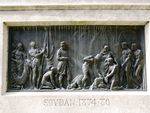
Home » Themes » People » Foreigners
General Charles GordonPrint Page 
The sculpture commemorates British General Charles Gordon, hero of Khartoum, Sudan, and depicting relief scenes from his life.
Major-General Charles Gordon died as Khartoum fell to the forces of the messianic Islamic leader, Mohammed Ahmed, the Mahdi, on 26 January 1885. Melbourne`s grief was intense. The public appeal to pay for the statue was so over-subscribed that enough remained to build a boys` home
The bronze statue depicts Gordon holding his cane and Bible. In heroic style, the general stands over a shattered cannon, presumably to symbolise his ultimate triumph over the trials and tribulations of military victory and defeat.
Four bronze bas-reliefs feature on the limestone base, each depicting one of four key stages in Gordon’s life: his victories in China, his charitable activities in Gravesend, his governorship in Sudan and his death in Khartoum.
Gordon, the ‘Great Christian General’, was one of the most popular Englishmen of his day, and his reputation was forged on the battlefield and through his Christian activities at Gravesend. During his appointment as secretary to the viceroy of India in 1880, Gordon became unpopular with the government of the day for passionately campaigning for native rule in countries such as Botswana, South Africa and Ireland. Gordon met his death 1885, when as governor-general of the Sudan he refused to evacuate Egyptian forces from Khartoum, believing this to be unsafe.
Gordon’s death was mourned throughout the British Empire. So great was the Australian public’s response that a fund to produce a copy of Thornycroft’s London monument for Melbourne was heavily oversubscribed. Perhaps due to oversubscription, Thornycroft produced the four reliefs for the limestone base, which are not found on the London statue. Although Gordon did not set foot on Australian soil, the monument is of great historical importance; his death prompted the dispatch of the first Australian troops overseas, a regiment from New South Wales.
Melbourne, June 26. A memorial statue to General Gordon, the hero of Khartoum, erected by public subscription in the Parliamentary reserve at Spring-street at a cost of £2,500, was unveiled today by the acting- Governor in the presence of a crowd which numbered over 8,000 people. The statue, which is in bronze, is the work of Mr. Hamo Thornycroft, the famous sculptor. It represents General Gordon standing in a contemplative attitude with his arms folded on his chest and with one foot resting on a broken cannon. The pedestal is a high one of granite, on the four sides of which scenes from the life of Gordon are depicted in bronze relief. The inscription is as follows : — "Erected by the people of Victoria to honor the memory of Chas. George Gordon, Major-General Royal Engineers, who fell at Khartoum, 26th January, 1885 'I have tried to do my duty.' ''
The proceedings commenced by the secretary reading the report of the committee, which stated that altogether £5,000 had been collected by public subscription. After paying the cost of the statue and all other expenses a surplus of £1,500 remained, which was to be given to the Gordon Institute for training friendless and struggling boys. His Excellency delivered a short address, and unveiled the statue amidst cheers. The Gordon Cadet Band then played the 'Dead March.' Major-General Downes, who was one time a brother in arms of General Gordon, delivered a eulogism on the dead hero, after which the proceedings terminated by the chorus of the Princess Theatre singing the National Anthem. The statue, which is a magnificent one, is prominently situated, and can be seen from Collins, Bourke, Spring, and Gisborne streets.
South Australian Chronicle (Adelaide), 29 June 1889.
He received a commission for a replica of Gordon for the town of Melbourne. This second Gordon had an even more elaborate pedestal with four bronze panels representing scenes in Gordon`s career, namely : Gordon in China, Gordon teaching the boys at Ragged School Gravesend, Gordon freeing slaves in Africa, and The Death of Gordon at Khartoum. This last he modelled form first-hand descriptions.
[" Marble & Bronze, the art and life of Hamo Thornycroft" by Elfrida Manning]
He (Thornycroft) had been to France, and was struck with the direction in which art was tending. It was becoming more modernized, more typical of the day in which we live as representing the history of our own existence, instead of speculating on the ancients. So he started and complete his first great public statue - General Gordon, which now stands in Trafalgar square, and a replica of which is in Melbourne.
“I have reasons to believe that the work was given to me at the instigation of Sir Frederick Leighton and Sir John Millais, and I was engaged on it for two and a half years. The model I employed was an Englishman. I read up as many lives of Gordon as I could, being particularly impressed whit his career in China. I never saw him, but he grew in my mind the hero he undoubtedly was. I remember hearing an Italian office say : ‘No country in the world could produce a man like Gordon except England.’ So I conceived the man – of wonderful strength of mind. Love. Kindness, affection – all these,, and such I endeavoured to suggest in my figure.
The Bible in his hand is exactly like the one he used – now in possession of the Queen. I was very much helped by photographs, particularly by a full length one taken in China ; but I was anxious to obtain some personal description, and it was over this that I had the two widest opinions as to a man’s appearance I have ever heard. I asked Sir Henry Gordon for some information on this point.
‘My brother`. He said ‘was a fine soldierly fellow ; stalwart, well set up and erect like this,` and Sir Henry pulled himself up. I went further and asked a fellow officer of Gordon`s.
`Oh !` he assured me, `rather humped-back like this` and he too illustrated his meaning. The divergence was so great that I fell back upon the photos.
The small quotation of the pedestal, `Right fears no might` is my own. As you know, the Trafalgar Square pedestal has two panels - `Fortitude and Faith` and `Charity and Justice`. The replica, which was commissioned by the Australian s- who sent a contingent up the Nile to relieve him – has four panels, including the death scene in Khartoum, which I modelled from first – hand descriptions.”
[ Extract from article on Sir Hamo Thonycroft in the Strand Magazine ]
Location
| Address: | Spring & Macarthur Streets, Gordon Reserve, East Melbourne, 3002 |
|---|---|
| State: | VIC |
| Area: | Foreign |
| GPS Coordinates: | Lat: -37.812727 Long: 144.973943 Note: GPS Coordinates are approximate. |
Details
| Monument Type: | Sculpture |
|---|---|
| Monument Theme: | People |
| Sub-Theme: | Military |
| Designer: | Sir Hamo Thornycroft |
Dedication
| Actual Monument Dedication Date: | Wednesday 26th June, 1889 |
|---|
Erected by the people of Victoria to honour the memory of Charles George Gordon Major-Gen Royal Engineers who fell at Khartoum January 26 - 1885
"I have tried to do my duty"
"This is the happy warrior - this is he that every man in arms should wish to be."
Gravesend 1865 - 71
"He sought for little children, to feed and clothe and train."
Soudan 1874 - 80
"He sought to save the lost, and bid the oppressed go free"
"Warrior of God, man`s friend, not laid below. But somewhere dead far in the waste Soudan, thou livest in all hearts, for all men know, this earth hath borne no simpler, noble man."
Khartoum 1885
"He would not desert those dependent on him while life remained"
China 1863 - 4
"He rescued provinces from anarchy but would accept no reward"











